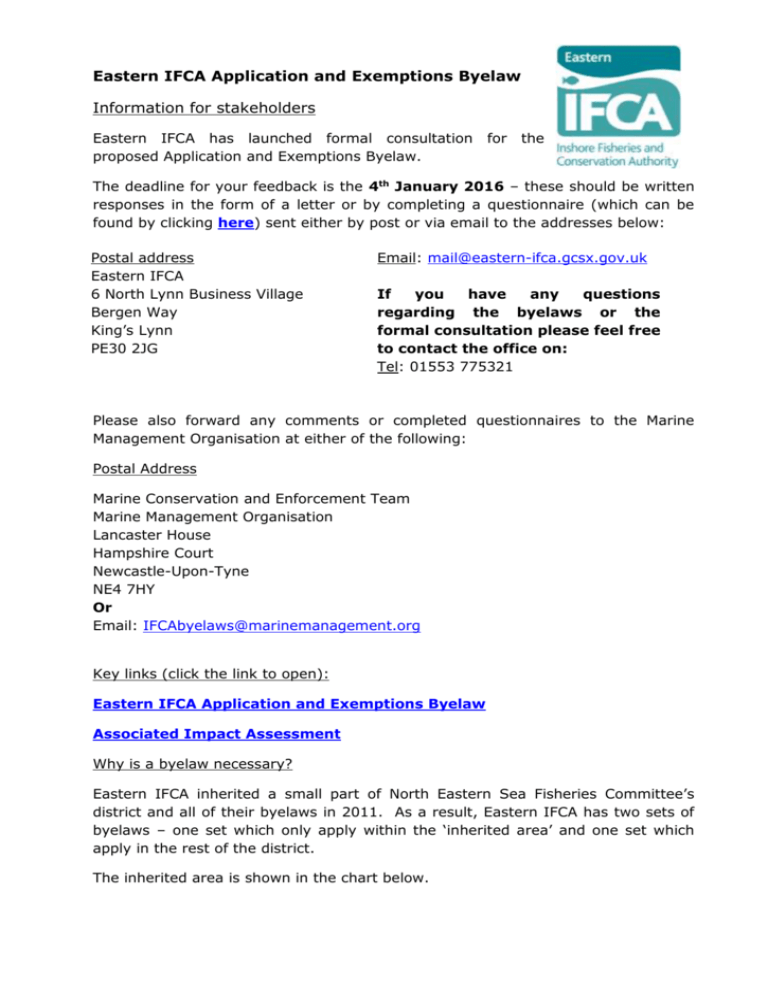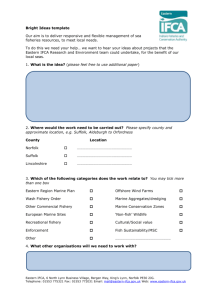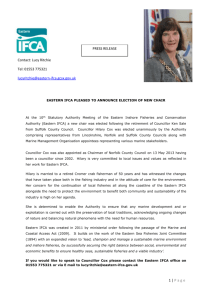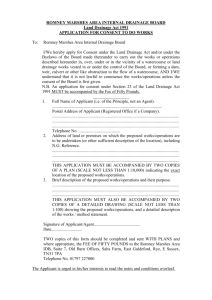
Eastern IFCA Application and Exemptions Byelaw
Information for stakeholders
Eastern IFCA has launched formal consultation
proposed Application and Exemptions Byelaw.
for
the
The deadline for your feedback is the 4th January 2016 – these should be written
responses in the form of a letter or by completing a questionnaire (which can be
found by clicking here) sent either by post or via email to the addresses below:
Postal address
Eastern IFCA
6 North Lynn Business Village
Bergen Way
King’s Lynn
PE30 2JG
Email: mail@eastern-ifca.gcsx.gov.uk
If
you
have
any
questions
regarding the byelaws or the
formal consultation please feel free
to contact the office on:
Tel: 01553 775321
Please also forward any comments or completed questionnaires to the Marine
Management Organisation at either of the following:
Postal Address
Marine Conservation and Enforcement Team
Marine Management Organisation
Lancaster House
Hampshire Court
Newcastle-Upon-Tyne
NE4 7HY
Or
Email: IFCAbyelaws@marinemanagement.org
Key links (click the link to open):
Eastern IFCA Application and Exemptions Byelaw
Associated Impact Assessment
Why is a byelaw necessary?
Eastern IFCA inherited a small part of North Eastern Sea Fisheries Committee’s
district and all of their byelaws in 2011. As a result, Eastern IFCA has two sets of
byelaws – one set which only apply within the ‘inherited area’ and one set which
apply in the rest of the district.
The inherited area is shown in the chart below.
The ‘inherited area’ (coloured
in with red shading on the
chart) consist of the sea out to
six nautical miles between:
1.
2.
The control tower at the
Royal Air Force Gunnery
and Bombing Range at
Donna
Nook
in
Lincolnshire – (Latitude 53
28.22’N
Longitude
0
09.24’E); and
Haile
Sand
Fort
in
Lincolnshire (Latitude 53
32.09’ N Longitude 0
01.82E).
The two blue lines on the chart
running south to north indicate
the 3 and 6 nautical mile
boundaries.
This chart is not to be used
for navigational purposes
Figure 1. Chart showing the location of the ‘inherited
area’. Within this area – Only those byelaws inherited
from North Eastern Sea Fisheries Committee apply.
(c) British Crown and SeaZone
Solutions Limited.
All rights
reserved.
Licence
No.
092009.021. This product has
been derived in part from
material obtained from the UK
Hydrographic Office with the
permission of the Controller of
Her Majesty’s Statutory Office
and UK Hydrographic Office.
To remedy this situation such that there is consistency across the whole Eastern
IFCA district, Byelaw 2 (Application and Saving for Scientific Purposes) of Eastern
IFCA’s byelaws needs to be revoked and remade.
Byelaw 2 (Application and Saving for Scientific Purposes) sets out where Eastern
IFCA’s byelaws apply – it currently refers to the Eastern Sea Fisheries Committee’s
district which does not include the inherited area.
What is the proposed Application and Exemptions Byelaw?
The proposed byelaw will have the effect of redefining the spatial application of
Eastern IFCA byelaw to include the inherited area by revoking Byelaw 2
(Application and Saving for Scientific Purposes) and replacing it with the proposed
byelaw.
It will mirror the provisions of Byelaw 2 (Application and
Purposes) to allow Eastern IFCA to grant exemptions form
surveys and breeding and stocking purposes. The byelaw
provision to allow Eastern IFCA to grant exemptions for
management’.
Saving for Scientific
byelaws for scientific
will also include the
reasons of ‘fisheries
The proposed byelaw will also revoke 15 North Eastern Sea Fisheries Committee
byelaws which were inherited by Eastern IFCA. In doing so, the byelaws will
effectively be replaced by Eastern IFCA byelaws.
What will the impacts of the byelaw be?
The fishing activity which could be impacted by these changes is potting for crabs
and lobster within the inherited area. The differences between the inherited
regulation and the proposed regulation are as follows:
Removal of parts of shellfish
Several IFCAs have byelaws which prohibit the landing of crabs and lobsters unless
they are landed whole – i.e. it is prohibited to land a crab claw detached from the
rest of the crab. Under the current regulation in the inherited area, it is permitted
to land parts of edible crab (Cancer pagurus) and velvet crabs (Necora puber) if:
•
The parts of crab do not make up more than 10% by weight, the total landed
catch on one occasion; or
•
The crab was caught in a trammel, gill or other enmeshing net and the claw
became detached from the crab in clearing the net.
Please refer to the full byelaw on our website for more details
Under the proposed regulations it would be prohibited to land any parts of crabs
(edible crabs or velvet crabs) regardless of how it was caught or its percentage
with regards to total catch.
Using edible crab for bait
Under the current regulations it is permitted to use edible crab (Cancer pagurus)
within the inherited area if that crab is cooked offal.
Under the proposed regulations it would be prohibited to use any edible crab as
bait even if cooked offal.
Four inherited byelaws will not be revoked. These byelaws have been identified as
requiring further review.
A full list of the byelaws which will be revoked can be found in Annex 1 – which also
includes rationale for why they are to be revoked.
Have your say
If you have any comments or objections to the measures please use the
information at the top of this information to respond by the 4th January 2016.
Please also forward representations to the MMO.
North Eastern
IFCA BYELAW
Summary of Offence
/ Byelaw
II. Application &
Saving for
scientific
purposes
III. Trawling
Prohibition :
Exceptions
EIFCA
Equivalent
(Y/N)
Y - Byelaw 2 :
EIFCA refers to
sec 6 Sea
Fisheries
Regulation Act
1966, NEIFCA
refers to Section
13 Sea Fisheries
Regulation Act
1888
Trawling without a
Permit
Recommended
Action
Explanation
Economic
Impacts
(Including the
impact of
replacing with
Eastern
Byelaw)
Environmen
tal Impacts
(Including
the impact of
replacing
with Eastern
Byelaw)
ESFJC equivalent includes more up-todate legislation
N/A
N/A
The NESFC byelaw prohibits fishing
within the inherited area. Removal of
this byelaw would allow trawling in the
inherited area - Options for removal
include extending EIFCA byelaw 12
(which would restrict the length of
vessels which can trawl) or amending
our byelaw 12 to include a prohibition
in this area. There are important sole
nursery/spawning grounds around the
Humber Estuary. There is a case to
keep it until EIFCA byelaw 12 is
reviewed.
N/A
N/A
Revoke
N - eastern IFCA
only has trawling
restrictions in
specified areas
Retain - further
review
IV. Seine Net,
Draw Net
Prohibition
Use of a Seine net, or
any drawn net of the
kind known as the
Danish seine or
'snurrevaad'
N
Revoke
V. Push Net
Push nets must be
raised and cleared at
least once in every half
hour
N
Revoke
VIII. Mussels :
Minimum Size
removal from a fishery
of mussels less than
51mm in length
Y - Byelaw 4 :
Minimum sizes
differ between the
two byelaws
Revoke
The NESFC byelaw prohibits the use of
siene nets (and snurrevaad) in this
area. The byelaw is generic and
doesn’t specify this area. Need to
consider the impact of allowing seine
netting in this area (i.e. sole grounds)
and the current level of activity would seine netting have an impact on
the sole grounds?
N/A
Potential
conflict with
the sole
spawning
grounds need to
consider the
likelihood of
this activity
actually
taking place
should the
byelaw be
revoked
The NESFC byelaws prohibits the use
of shrimp push nets in this area. This
byelaw is generic and doesn’t specify
this area. Need to consider impact of
allowing push netting in this area (i.e.
sole grounds) and the current level of
activity.
N/A
Potential
conflict with
the sole
spawning
grounds need to
consider the
likelihood of
this activity
actually
taking place
should the
byelaw be
revoked
There are currently no known mussel
beds within inherited part of Eastern
IFCA district - Eastern IFCA has no
reason to believe an increase in the
MLS of mussel is required within its
district. Removal of this byelaw will
make regulation across district
N/A - Positive
Potential
impact on
mussels if
taking
smaller size
consistent.
X. Re-Deposit of
Shellfish
XI. Regulations
of Shellfish Beds
XII. Shrimp &
Prawn Fishing
XIV. Prohibition
of Removal of
parts of lobsters
from any fishery
Removal of prohibited
shellfish - must be
redeposit as close as
possible to the place
from which it was
taken.
Y - Byelaw 9
Removal of shellfish
from a closed area
Y - Byelaw 8
Failure to raise or clear
nets when fishing for
shrimp or prawn, at
least once in every hour
Removal of lobsters
below MLS, or tail, claw
or any other detached
part of a lobster
This byelaw represents a duplication
of the EIFCA byelaw and can be
removed with no effect.
N/A
N/A
N/A
N/A
Revoke
EIFCA has an equivalent byelaw Byelaw 8 includes the ability to
temporarily close a bed for 'protection
of the fishery' which may include more
metrics than juvenile density and
stock levels. EIFCA byelaw is more
appropriate.
N/A
N/A
Retain - further
review
The byelaw requires fishers to lift and
clear gear every hour - presumably to
prevent the death of by-catch. Given
that the area is a sole nursery area
this is likely to be important. EIFCA
are currently reviewing shrimp
measures with a view to implement
new measures. There is a case to
keep this byelaw and look to revoke it
at conclusion of our shrimp measures.
This byelaw duplicates the Eastern
IFCA byelaw 7 but includes more
species - includes edible crab and
velvet crab
Potential
impact if
current fishing
practices
include
landing parts
N/A positive
Revoke
N
Y - Byelaw 7 refers to edible
crab, velvet crab
and lobsters
Revoke
of velvet crab
or edible crab
XV. Application
of Byelaws
XVIII. Fixed
Engine
(Authorisation)
Byelaw
XIX. Parts of a
Crab
Byelaws in force prior to
22nd Dec 1992 apply
only to inside three
nautical miles from
baselines
N - Reference is
made to where
byelaws are
applied in the
paragraph prior to
Byelaw 1.
Use of fixed engines
only in specified areas,
for specified species and
for a period of 5 years
after the date the
byelaw was made.
Y - BYELAW 13 this prohibits the
use of fixed
engines in waters
inland of the
ESFJC District
except where
historical rights of
several fisheries
make the
prohibition exempt
prevents the landing of
parts of a crab which
cannot be measured to
ensure compliance with
the MLS, with the
exceptions stated as (a)
and (b)
Y - Byelaw 7 refers to edible
crab, velvet crab
and lobsters
Not relevant
N/A
N/A
Removal of this byelaw would allow
the targeting of sole, cod and all sea
fish within 'Box B'. The byelaw
specifically names an area within
Eastern IFCA's district which is also a
known sole spawning/nursery area.
Revoking this byelaw would potentially
have impacts on the sustainability of
sole fisheries. Recommendation is to
keep this byelaw and remake at a
later stage in line with up-to-date
byelaw guidance.
N/A
N/A
Eastern IFCA byelaw is more
restrictive - i.e. NESFC byelaw has
exemptions where it is permitted to
remove parts of (edible crab) - if
removed the increased regulation
would need to be reflected in an
Impact Assessment
Potential
impact if parts
of crab is
caught as bycatch (not
more than
10%) or by a
trammel, gill,
entangling
etc. Should
consider
potential loss
of earnings if
this is
N/A positive
Revoke
Retain - further
review
Revoke
prohibited.
XX. Prohibition
on use of
Crab(Cancer
Pagurus) for
Bait
use of edible crab for
bait with the exception
of cooked crab offal
XXI. Protection
of 'V' notched
lobsters
fishing for or taking
lobster which have a vnotch in any of their tail
fan flaps, or which have
any form of mutilation
to any of the tail fan
flaps
N - SI (2000
No.874) prohibits
the landing of vnotched lobsters
fishing for or removing
lobster, crab, velvet
crab or whelk without a
specified permit
N
XXII. Permit to
fish for lobster,
crab, velvet
crab and whelk
Y - Byelaw 5 - no
reference is made
to cooked crab
offal being an
exception
Revoke
Revoke
Revoke
Eastern IFCA byelaw is more
restrictive - i.e. has no exception for
cooked crab offal. This increase in
regulation will need to be reflected in
an IA
Potential
impact on cost
of bait if
cooked offal is
currently
being used as
bait.
Potential
impact if
fishers start
capturing
other bait
sources
The Lobsters and Crawfish (Prohibition
of Fishing and Landing) Order 2000
(SI 874) prohibits the fishing of v
notched or mutilated lobsters however
the byelaw would allow for fishers not
associated with a relevant vessel (i.e.
recreational fishers). There is unlikely
to be a significant impact on the
lobster fishery from recreational
fishers taking lobster in this area should be considered in IA.
N/A
Potential for
v-notched
lobsters to
be caught by
recreational
fishers
Removal of this byelaw will allow
fishing for the species prescribed in
the byelaw to occur as in the rest of
Eastern IFCA district - as we do not
currently issue any permits for this
area fishing for these species is
currently banned in the inherited area.
Removal would bring fisheries
management in line with rest of
district and will potentially be
considered during Whelk
byelaw/potting byelaw. It currently
N/A - Positive
(technically
potting is
prohibited din
this area as
we have not
issued any
permits)
Lobster,
edible crab
and velvet
crab fishing
could take
place without
any
conditions on
gear which
could have
an impact.
Whelk effort
is controlled
under the
EIFCA whelk
byelaw.
contradicts the whelk potting byelaw.
XXIII. Method
and area of
fishing
(Dredges)
byelaw
Use of a dredge other
than between 1st July
and 30th September,
dredges must be limited
to max of 10 and of
specified construction.
Dredging is not
permitted inside 3nm
from baselines
Y - Byelaw 3,
byelaw 15
XXIV. Humber
Estuary Cockle
Fishery Byelaw
Removal or disturbance
of cockle without a
permit
Y/N - Byelaw 3 prevents the
removal of cockles
except by hand,
hand-rake or gear
approved by the
Authority. Byelaw
8 allows us to
close a shellfish
bed. Byelaw 11
allows us to ask
for returns.
XXV. Prohibition
on removal of
tope or parts
thereof
Removal of tope or the
species (Galeorhinus
galeus) of parts thereof.
N/A
N/A
Revoke
Byelaw relevant to scallop dredging
which is prohibited under the byelaw.
Fishers will not be able to use any
gear to take scallops (or any shellfish
prescribed in Byelaw 3) without
authorisation from Eastern IFCA under
byelaw 3. As such we have a byelaw
which has the same protective effect
at the moment.
N/A
N/A
Retain - further
review
Permits will be provided to anyone on
demand who accurately completes an
application form - we can only refuse
a permit on the grounds that the
application form is not complete. i.e.
there would be no real way to limit the
number of permits under this byelaw.
use of byelaw 8 and 11 of our byelaws
could be used in its stead however we
would still have same issue.
Recommended that the byelaw
remains in place until further review
can be completed.
Eastern IFCA equivalent
N/A
N/A
Y - Byelaw 14
Revoke
XXVIII.
Crustacea
Conservation
Byelaw
Use of pots, creel or
traps which do not meet
the guidelines set out in
the byelaw
N
Revoke
This byelaw does not apply in the
inherited part of Eastern IFCA's
district
N/A
N/A









